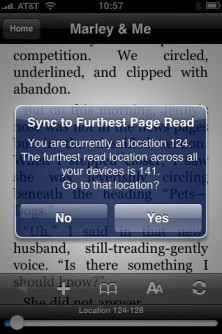 The news today that Amazon has released a Kindle client for Apple’s iPhone and iPod touch says a lot about the company’s eBook strategy. Amazon’s Kindle device has often been described as wanting to become the iPod of books, but unlike Apple it’s clear that the e-tailer sees itself in the business of selling content and not just to drive sales of hardware.
The news today that Amazon has released a Kindle client for Apple’s iPhone and iPod touch says a lot about the company’s eBook strategy. Amazon’s Kindle device has often been described as wanting to become the iPod of books, but unlike Apple it’s clear that the e-tailer sees itself in the business of selling content and not just to drive sales of hardware.
In terms of music and video sales, Apple’s iTunes Store exists purely to add value to and increase uptake of the company’s iPod and AppleTV devices, with the major record labels and Hollywood studios receiving the majority of revenue from any content sold. Until fairly recently, content from iTunes could only play back on Apple’s hardware – for movies and TV shows this is still the case – helping to lock customers into the iTunes/iPod ecosystem. In contrast, eBooks bought from the Kindle store are now able to be read on at least one non-Kindle device, Apple’s iPhone, with more to come. This suggests to me that Amazon is taking a large enough cut from each eBook sold to justify potentially diluting sales of the Kindle device itself.
Having said that, Amazon is publicly pitching its iPhone app as being complementary to the Kindle rather than competing directly against it. And in some ways this is true. There’s a high degree of synergy between the Kindle experience on either device. Using technology Amazon is calling Whispersync users can pick up reading where they left off from the Kindle to iPhone and vice versa. Additionally, since eBooks purchased through the Kindle store are kept on Amazon’s own servers, you can access any content from your existing Kindle library ‘over the air’ on the iPhone or iPod touch.
However, aside from the Kindle’s superior e-ink screen technology, which is optimized for readability, there are a number of features that are missing from Amazon’s iPhone app. Most notable is the inability to browse and make purchases from the Kindle store directly within the app itself, instead you’ll need to fire up the iPhone’s web browser or make purchases first via a Kindle or desktop PC. Another omission, reports mocoNews, is access to newspapers, magazine and blog “subscriptions”, which due to copy-protection are currently tied to a single Kindle device.
